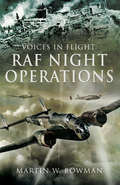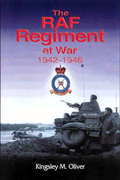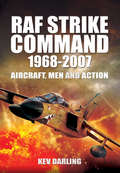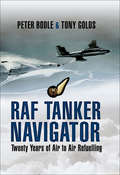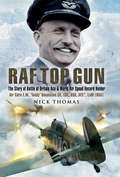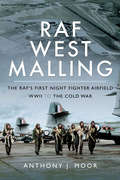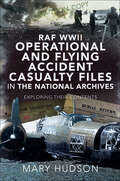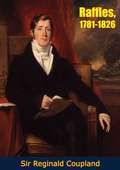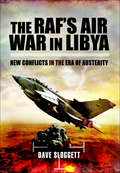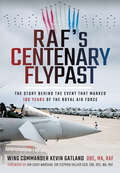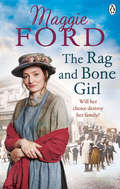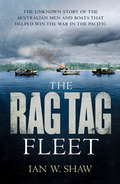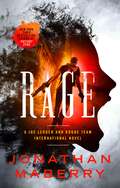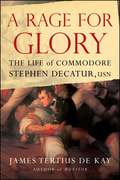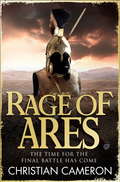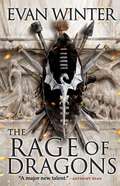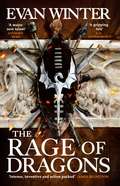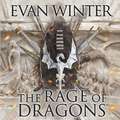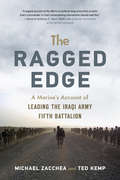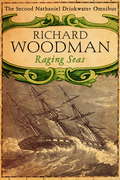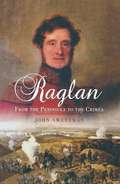- Table View
- List View
RAF Night Operations: Raf Night Operations (Voices in Flight)
by Martin W. Bowman'The Navy can lose us the war, but only the Air Force can win it. Therefore our supreme effort must be to gain overwhelming mastery in the air. The Fighters are our salvation but the Bombers alone provide the means of victory...' So said Prime Minister Winston Churchill to the War Cabinet on the first anniversary of the outbreak of war. But when Britain declared war on Germany in September 1939 her bombers were predominantly twin-engined types like the Wellington, Whitley and the Hampden which after suffering carnage during the day were soon switched to night operations.Wartime speeches alone cannot begin to describe the misery and fortitude, desperation and terror endured by the civilian population during the 'Blitz Nights' in Coventry, the London docklands and the East End as night after night bombs and incendiaries rained down on them. Their personal experiences and those of war correspondents like James Negley Farson are as vivid, poignant and descriptive as those of the bomber crews carrying the war to the enemy in the early night bomber offensive. These too are mostly recounted at first hand, sometimes in BBC broadcasts to the nation; and they include 'The Unanswerable Double'; 'Winged Words'; 'German Defences'; 'Getting Frightened'; 'Jump For It!'; 'The Night The Fuel Ran Out'; 'Flames, Flares and Fires'; 'Busted Flush'; 'The Tail Gunner's Story' and 'Hampden and 'Wimpy' Ops'. They tell just what it was like to fly in a heavy bomber over occupied Europe.
The RAF Regiment at War, 1942–1946
by Kingsley M. OliverBorn out of necessity in the dark days of the War, the RAF Regiment found itself in the thick of the action supporting the vital operations in all theaters. This comprehensive record of their operations gives the clearest indication of the contribution that the Regiment made and includes many first hand accounts of the fighting, including the first shooting-down of a jet aircraft, the Me 262A-2a Sturmvogel in November 1944. As a result of their outstanding contributions to the success of RAF operations in WW2, the Regiment became a permanent part of the RAF. This is the official history of the RAF Regiment from its foundation 60 years ago to the aftermath of hostilities.
RAF Strike Command, 1968–2007: Aircraft, Men and Action
by Kev DarlingAviation author Kev Darling looks at the origins of the World War Two Royal Air Force commands and histories in RAF Strike Command.In 1968, the RAF Commands that had become famous in World War Two—Fighter, Bomber, Coastal, Air Support and Signals Commands—were combined into the single Strike Command, an amalgamation that served throughout the remaining years of the Cold War, in the Falklands, and in the Middle East in Operations Desert Shield, Desert Storm and Granby. This organizational change caused re-equipment, base changes and increasing economic constraints. The Royal Navy was now responsible for the UK’s nuclear deterrent in the form of their Polaris submarines, so the RAF’s V-Bomber Force were now relegated to tanker operations, with the exception of the lone Vulcan that was sent to the Falklands conflict. The Command’s fleet of fast jets became more adaptable, with single types assuming the roles of fighter, bomber, reconnaissance, and maritime attack. The aircraft also became multinational in their design and manufacture as Britain’s postwar lead in aircraft design had been frittered away by years of thoughtless government, leading to a single company for production. Apart from the brilliant Harrier which the US continues to develop and build, other aircraft flown by the Command were from European syndicates, such as the Tornado and Jaguar. The US supplied the transports in the form of the faithful Hercules, and Europe most of the helicopter fleet.Exploring the operations that took place during this military wing’s existence, the aircraft they flew and the men who flew them, RAF Strike Command is a tribute to the fast-dwindling power of the Royal Air Force.
RAF Tanker Navigator
by Peter Bodle Tony GoldsThis book gives a rare insight into the life inside the tanker squadrons of the Royal Air Force, viewed through the eyes of Tony Golds, one of the R.A.F. tanker fleets longest serving Navigator/Plotters. During his service career which spanned four decades, he flew in dozens of airplanes, for literally thousands of hours and covered something in excess of two million miles. Initially the prime role of the first tankers (Valiants) was to service the legendary English Electric Lightning interceptor fighters patrolling the North Sea. During his career, Tony served in every continent of the world, including a healthy series of tours at Ascension just after the Falklands War. He was in one of the tanker crews chosen to assist in devising the procedures needed to get both the Vulcans in the Black Buck operation down to the Falklands, and subsequently the Hercules C130 freighters to form the Ascension / Falklands air bridge, so vital for the support of the Falkland Islands, once the shooting war was over.
RAF Top Gun: The Story of Battle of Britain Ace and World Air Speed Record Holder Air Cdre E.M. 'Teddy' Donaldson CB, CBE, DSO, AFC*, LoM (USA)
by Nick ThomasEdward Teddy Mortlock Donaldson was one of three aviator brothers to win the D.S.O. during World War II. He joined his brother in the R.A.F. and was granted a sort-service commission. He quickly became both a stunt pilot and a crack-shot, winning the R.A.F.s Gunnery Trophy One and leading the R.A.F.s aerobatic display team. When war was declared Donaldson was commanding No 151(F) Squadron flying Hurricanes and in their first engagement destroyed six enemy aircraft, shooting down many more in the following months. For his leadership of the squadron during the battle and his personal tally of eleven, plus ten probable destruction's he was awarded the D.S.O. He then spent three years as a gunnery instructor in the USA where he taught American Gun Instructors and helped set up new gunnery schools. On his return to England he converted onto jet aircraft and commanded a Meteor squadron. This lead to him being selected to command the Air Speed Flight, established in 1946 to break the world record. Teddy eventually snatched the title, setting a new speed record and breaking the 1000 km/h barrier. He retired as an Air Commodore and became the Air Correspondent for the Daily Telegraph. He died in 1992.
RAF West Malling: The RAF's First Night Fighter Airfield, WWII to the Cold War
by Anthony J. Moor&“Inspiring history of the first designated night fighter base . . . an important piece of social and military history . . . a must-read!&” —Books Monthly Anthony J. Moor&’s exhaustively researched and highly illustrated book is the first to tell the full story of the part West Malling played in the defense of the United Kingdom, and how it served the RAF for twenty-eight action-packed years. Opened as a private landing ground after the First World War, the airfield at West Malling became home to the Maidstone School of Flying in 1930. The airfield&’s RAF role came to the fore in June 1940; by then the station had been fitted with a concrete runway. The first aircraft arrived on 8 June 1940. As the UK&’s first designated night fighter base, over the years that followed, RAF West Malling was home to many famous pilots—men such as John Cunningham, Peter Townsend, Bob Braham and even Guy Gibson, later of Dambusters fame. During the summer of 1944, Mosquitoes, Spitfires and Mustang Mk.3s successfully destroyed many V-1s, as well as played their part in the D-Day landings. West Malling&’s strategic night fighter role continued into the Cold War, when No.500 (Kent&’s Own) Squadron adopted it as its home in this period. A US Navy Facility Flight was also based at the airfield in the 1960s. After closure as an operational air station in 1969, West Malling re-acquired its civilian guise, hosting a Gliding School, Short Brothers and several major Great Warbirds Air Displays during the 1970s and 1980s, until eventually closing completely as an airfield, for re-development.
RAF West Malling: The RAF's First Night Fighter Airfield, WWII to the Cold War
by Anthony J. Moor&“Inspiring history of the first designated night fighter base . . . an important piece of social and military history . . . a must-read!&” —Books Monthly Anthony J. Moor&’s exhaustively researched and highly illustrated book is the first to tell the full story of the part West Malling played in the defense of the United Kingdom, and how it served the RAF for twenty-eight action-packed years. Opened as a private landing ground after the First World War, the airfield at West Malling became home to the Maidstone School of Flying in 1930. The airfield&’s RAF role came to the fore in June 1940; by then the station had been fitted with a concrete runway. The first aircraft arrived on 8 June 1940. As the UK&’s first designated night fighter base, over the years that followed, RAF West Malling was home to many famous pilots—men such as John Cunningham, Peter Townsend, Bob Braham and even Guy Gibson, later of Dambusters fame. During the summer of 1944, Mosquitoes, Spitfires and Mustang Mk.3s successfully destroyed many V-1s, as well as played their part in the D-Day landings. West Malling&’s strategic night fighter role continued into the Cold War, when No.500 (Kent&’s Own) Squadron adopted it as its home in this period. A US Navy Facility Flight was also based at the airfield in the 1960s. After closure as an operational air station in 1969, West Malling re-acquired its civilian guise, hosting a Gliding School, Short Brothers and several major Great Warbirds Air Displays during the 1970s and 1980s, until eventually closing completely as an airfield, for re-development.
RAF WWII Operational and Flying Accident Casualty Files in The National Archives: Exploring Their Contents
by Mary Hudson“A journey through the original RAF Casualty Branch files, and all the other available sources of information relating to RAF wartime casualties.” —Military Historical SocietyAt its height during the Second World War, the RAF totaled 185,000 personnel. All information concerning casualties was carefully complied at the Air Ministry and now, from these the official records, those covering operational losses (in the air and on the ground) and flying accidents are being made available to the public through The National Archives.This huge collection of casualty files contains a wealth of contemporary documentation from a variety of sources including captured German records. It includes official documents, examples of which are given, accounts of searches undertaken to establish the fate of the missing, places of burial, copies of information received from the International Red Cross and from sources within enemy occupied lands, as well as letters from family and friends some of which reveal dark secrets of bigamy, adultery, illegitimacy, debt and dishonor.In this groundbreaking book, Mary Hudson has used her expert knowledge to provide an invaluable guide to the understanding of these records for use by researchers and family members alike. “An intriguing work bringing the fruits of many years of inside experience into the hands of those trying to find the missing piece in the jigsaw of a family tree or any RAF historian.” —The Shackleton Association“Fascinating . . . illustrates the dedication of the teams who handled the difficult issues of death and the missing in a very compassionate and dedicated manner.” —Journal of The Orders & Medals Research Society
RAF WWII Operational and Flying Accident Casualty Files in The National Archives: Exploring Their Contents
by Mary Hudson“A journey through the original RAF Casualty Branch files, and all the other available sources of information relating to RAF wartime casualties.” —Military Historical SocietyAt its height during the Second World War, the RAF totaled 185,000 personnel. All information concerning casualties was carefully complied at the Air Ministry and now, from these the official records, those covering operational losses (in the air and on the ground) and flying accidents are being made available to the public through The National Archives.This huge collection of casualty files contains a wealth of contemporary documentation from a variety of sources including captured German records. It includes official documents, examples of which are given, accounts of searches undertaken to establish the fate of the missing, places of burial, copies of information received from the International Red Cross and from sources within enemy occupied lands, as well as letters from family and friends some of which reveal dark secrets of bigamy, adultery, illegitimacy, debt and dishonor.In this groundbreaking book, Mary Hudson has used her expert knowledge to provide an invaluable guide to the understanding of these records for use by researchers and family members alike. “An intriguing work bringing the fruits of many years of inside experience into the hands of those trying to find the missing piece in the jigsaw of a family tree or any RAF historian.” —The Shackleton Association“Fascinating . . . illustrates the dedication of the teams who handled the difficult issues of death and the missing in a very compassionate and dedicated manner.” —Journal of The Orders & Medals Research Society
Raffles, 1781-1826
by Reginald CouplandFirst published in 1926, this is a scholarly work on Sir Thomas Stamford Raffles, FRS (July 6, 1781 - July 5, 1826), a British statesman, Lieutenant-Governor of British Java (1811-1815) and Governor-General of Bencoolen (1817-1822), best known for his founding of Singapore. He was also heavily involved in the conquest of the Indonesian island of Java from Dutch and French military forces during the Napoleonic Wars and contributed to the expansion of the British Empire.
The RAF's Air War In Libya: New Conflicts in the Era of Austerity
by Dave SloggettThe uprising in Libya in the spring of 2011 took the world by surprise. The Gaddafi regimes brutal attempts at suppressing the uprising, however, soon prompted the international community to respond. NATO agreed to impose a no-fly zone across Libya, which was led by Britain, France and the USA.For the British Prime Minister, David Cameron, the deployment of RAF and Royal Navy assets in support of UN Resolution 1973, came at a time when severe cuts to the UKs defense spending were in the process of being enacted. With the Royal Navy aircraft carriers and their Harrier jets no longer available, would the UK be able to mount operations 3,000 miles away?In this, the first book to analyze the Libyan campaign, David Sloggett details the causes of the uprising, and examines each stage of the war through to its termination with the death of Colonel Gaddafi.In conclusion, Dr. Sloggett considers the future prospects for a post-Gaddafi Libya and, more significantly, how NATO in general and Britain in particular, will respond to similar events in the future.
RAF's Centenary Flypast: The Story Behind the Event that Marked 100 Years of the Royal Air Force
by Kevin Lee GatlandOn 10 July 2018, exactly 100 years and 100 days after the formation of the world’s first independent air force, 103 aircraft of twenty-four types from twenty-five squadrons flew over London in the largest formation of military aircraft seen over the capital of the UK in nearly thirty years. Involving over 250 aircrew and operating out of fourteen military and two civilian airfields, with nineteen back-up aircraft and a standby air-to-air refueling tanker, the Royal Air Force put on a unrivaled display to mark the centenary of its creation on 1 April 1918, in the closing months of the First World War. Exemplifying that long and proud history, was the Spitfire, Hurricane, Lancaster and Dakota of the Memorial Flight, as well as the enduring Hercules, with the newly acquired F-35B Lightning displaying the RAF’s continuing global importance. This book reveals how the flypast was conceived and examines the detailed planning involved in the event, written by someone who would know – the project manager and coordinator. The composition and size of the flypast was truly momentous, comprising virtually every type of aircraft that the RAF operated at the time. As Chief of Staff at the Tornado GR4 Force Headquarters operating from RAF Marham, and an experienced Tornado GR4 Navigator, Wing Commander Kevin Gatland had the task of pulling together all the necessary components, both military and civilian required to produce an unrivaled aerial display. This involved considering the feasibility of assembling so many varied types of aircraft, all with different speeds and capabilities, in addition to concentrating them into a tight schedule to produce a virtually continuous stream of aircraft over central London, with elements breaking off to pass over the northerly runway at Heathrow Airport, the RAF Memorial at Runnymede, Windsor Castle and the RAF Museum at Hendon. Beautifully illustrated with glorious color in-flight photographs of the magnificent aircraft of the current RAF as well as the briefing and planning session, this book demonstrates the enormous range of factors that had to be taken into consideration to produce the amazing spectacle that was witnessed by the Queen from Buckingham Palace and the thousands who gathered in The Mall – an event captured in the pages of this fascinating book.
The Rag and Bone Girl
by Maggie FordWhat will she sacrifice for love? Growing up in London’s East End with six siblings, Nora Taylor has always been close to her younger sister Maggie. But when she meets Maggie’s fiancé Robert, they are immediately drawn to each other. Forced to choose between her family and her heart, Nora decides to marry the man she loves – even if it means losing her sister.When the First World War breaks out, Nora must fight to hold her family together through the challenges and tragedies to come. As her children grow up they embark on their own adventures, but another war will threaten all their hopes for the future. Can this broken family survive the dark days of wartime?A sweeping saga charting one family’s fortunes through the First and Second World War and beyond, perfect for fans of Maggie Hope and Dilly Court.
The Rag Tag Fleet: The unknown story of the Australian men and boats that helped win the war in the Pacific
by Ian W. ShawThe fascinating - and unknown - story of the Rag Tag Fleet, a collection of hundreds of Australian fishing trawlers and schooners, organised by the US Army, which transported vital supplies for US and Australian forces across the South-East Pacific.Boys under the age of 17 and men over 60, and those who weren't well enough to join the Australian regular forces formed the crews. Each boat was armed with one machine gun - and sailed under the American flag.Conditions on the boats were grim. Numerous crew members contracted diseases including malaria, dysentery and dengue fever. Vulnerable to aircraft attack, the boats were frequently strafed and bombed.The story is told through the experiences of the Australian crew on half a dozen ships - including Jack Savage, boat builder extraordinaire; Ray Parer, air fighter, explorer and gold miner; and Norm Oddy, bandleader, drifter and mechanic.The focus of THE RAG TAG FLEET is the unknown story of the final months of 1942, when these men ran the gauntlet of Japanese air attacks, reefs and shallow, shark-infested waters to bring in the supplies and equipment for the US and Australian troops that defeated the entrenched Japanese forces at Buna on the PNG coast, and so helped turn the course of the war.
Rage: A Joe Ledger and Rogue Team International Novel (Rogue Team International Series #1)
by Jonathan MaberryFrom New York Times Bestselling author (creator of the Netflix series V Wars), Jonathan Maberry comes the first in a brand new series featuring Joe Ledger and Rogue Team International. A small island off the coast of Korea is torn apart by a bioweapon that drives everyone—men, women, and children—insane with murderous rage. The people behind the attack want Korea reunified or destroyed. No middle ground. No mercy. Soon Japan, China, and the United States are pushed to the brink of war, while terrorists threaten to release the rage bioweapon in a way of pure destructive slaughter. Joe Ledger leads his newly formed band of international troubleshooters in their first mission to stop the terror cell, fighting alongside agents from North and South Korea. With the lives of billions at stake, Ledger is willing to bring his own brand of terror to this frightening new war.
A Rage for Glory
by James Tertius de KayStephen Decatur was one of the most awe-inspiring officers of the entire Age of Fighting Sail. A real-life American naval hero in the early nineteenth century, he led an astonishing life, and his remarkable acts of courage in combat made him one of the most celebrated figures of his era. Decatur's dazzling exploits in the Barbary Wars propelled him to national prominence at the age of twenty-five. His dramatic capture of HMSMacedonianin the War of 1812, and his subsequent naval and diplomatic triumphs ...
Rage of Ares (The Long War)
by Christian CameronArimnestos of Plataea was one of the heroes of the Battle of Marathon, in which the heroic Greeks halted the invading Persians in their tracks, and fought in the equally celebrated naval battle at Salamis.But even these stunning victories only served to buy the Greeks time, as the Persians gathered a new army, returning with overwhelming force to strike the final killing blow.For the Greeks, divided and outnumbered, there was only one possible strategy: attack. And so, in the blazing summer of 479 BC, Arimnestos took up his spear one final time at the Battle of Plataea.
The Rage of Ares
by Christian CameronArimnestos of Plataea was one of the heroes of the Battle of Marathon, in which the heroic Greeks halted the invading Persians in their tracks, and fought in the equally celebrated naval battle at Salamis. But even these stunning victories only served to buy the Greeks time, as the Persians gathered a new army, returning with overwhelming force to strike the final killing blow. For the Greeks, divided and outnumbered, there was only one possible strategy: attack. And so, in the blazing summer of 479 BC, Arimnestos took up his spear one final time at the Battle of Plataea.
The Rage of Dragons (The Burning #1)
by Evan WinterGame of Thrones meets Gladiator in this debut epic fantasy about a world caught in an eternal war, and the young man who will become his people's only hope for survival. <P><P>The Omehi people have been fighting an unwinnable fight for almost two hundred years. Their society has been built around war and only war. The lucky ones are born gifted. One in every two thousand women has the power to call down dragons. One in every hundred men is able to magically transform himself into a bigger, stronger, faster killing machine. <P><P>Everyone else is fodder, destined to fight and die in the endless war. <P><P>Young, gift-less Tau knows all this, but he has a plan of escape. He's going to get himself injured, get out early, and settle down to marriage, children, and land. Only, he doesn't get the chance. Those closest to him are brutally murdered, and his grief swiftly turns to anger. Fixated on revenge, Tau dedicates himself to an unthinkable path. He'll become the greatest swordsman to ever live, a man willing to die a hundred thousand times for the chance to kill the three who betrayed him. <P><P>The Rage of Dragons launches a stunning and powerful debut epic fantasy series that readers are already calling "the best fantasy book in years.
The Rage of Dragons: The Burning, Book One (The Burning #1)
by Evan Winter'A captivating epic fantasy from a major new talent' Anthony Ryan, author of Blood Song***ONE OF TIME MAGAZINE'S 100 BEST FANTASY BOOKS OF ALL TIME*** IN A WORLD CONSUMED BY ENDLESS WAR ONE YOUNG MAN WILL BECOME HIS PEOPLE'S ONLY HOPE FOR SURVIVAL.The Omehi people have been fighting an unwinnable war for generations. The lucky ones are born gifted: some have the power to call down dragons, others can be magically transformed into bigger, stronger, faster killing machines. Everyone else is fodder, destined to fight and die in the endless war. Tau Tafari wants more than this, but his plans of escape are destroyed when those closest to him are brutally murdered.With too few gifted left, the Omehi are facing genocide, but Tau cares only for revenge. Following an unthinkable path, he will strive to become the greatest swordsman to ever live, willing to die a hundred thousand times for the chance to kill three of his own people.THE RAGE OF DRAGONS LAUNCHES AN UNMISSABLE EPIC FANTASY SERIES. 'Intense, inventive and action-packed from beginning to end - a relentlessly gripping, brilliant read' James Islington, author of The Shadow of What Was Lost'Stunning debut fantasy' Publishers Weekly'Intense, vivid and brilliantly realised - a necessary read' Anna Smith Spark, author of The Court of Broken Knives'Fans of Anthony Ryan's Blood Song will love this' Django Wexler, author of The Thousand Names'A Xhosa-inspired world complete with magic, dragons, demons and curses, The Rage of Dragons takes classic fantasy and imbues it with a fresh and exciting twist' Anna Stephens, author of Godblind
The Rage of Dragons: The Burning, Book One (The Burning #1)
by Evan Winter'A captivating epic fantasy from a major new talent' Anthony Ryan, author of Blood Song'Intense, inventive and action-packed from beginning to end - a relentlessly gripping, brilliant read' James Islington, author of The Shadow of What Was LostThe Omehi people have been fighting an unwinnable war for generations. The lucky ones are born gifted: some have the power to call down dragons, others can be magically transformed into bigger, stronger, faster killing machines. Everyone else is fodder, destined to fight and die in the endless war. Tau Tafari wants more than this, but his plans of escape are destroyed when those closest to him are brutally murdered.With too few gifted left the Omehi are facing genocide, but Tau cares only for revenge. Following an unthinkable path, he will strive to become the greatest swordsman to ever live, willing to die a hundred thousand times for the chance to kill three of his own people.THE RAGE OF DRAGONS LAUNCHES AN UNMISSABLE EPIC FANTASY SERIES ABOUT A WORLD CAUGHT IN AN ENDLESS WAR AND THE YOUNG MAN WHO WILL BECOME HIS PEOPLE'S ONLY HOPE FOR SURVIVAL'Utter and complete perfection. Winter has created an absolute masterpiece of a novel' The Bookbag'Intense, vivid and brilliantly realized - a necessary read' Anna Smith Spark, author of The Court of Broken Knives'Stunning debut fantasy' Publishers Weekly'Fans of Anthony Ryan's Blood Song will love this' Django Wexler, author of The Thousand Names'A Xhosa-inspired world complete with magic, dragons, demons and curses, The Rage of Dragons takes classic fantasy and imbues it with a fresh and exciting twist' Anna Stephens, author of Godblind'A gripping tale . . . with one of the most enthralling hero's journeys I've read' S. A. Chakraborty, author of City of Brass
The Ragged Edge: A US Marine's Account of Leading the Iraqi Army Fifth Battalion
by Michael Zacchea Paul D. Eaton Ted KempDeployed to Iraq in March 2004 after the overthrow of Saddam Hussein, US Marine Michael Zacchea thought he had landed a plum assignment. His team's mission was to build, train, and lead in combat the first Iraqi Army battalion trained by the US military.Quickly, he realized he was faced with a nearly impossible task. With just two weeks' training based on outdated and irrelevant materials, no language instruction, and few cultural tips for interacting with his battalion of Shiites, Sunnis, Kurds, Yazidis, and others, Zacchea arrived at his base in Kirkush to learn his recruits would need beds, boots, uniforms, and equipment. His Iraqi officer counterparts spoke little English. He had little time to transform his troops—mostly poor, uneducated farmers—into a cohesive rifle battalion that would fight a new insurgency erupting across Iraq.In order to stand up a fighting battalion, Zacchea knew, he would have to understand his men. Unlike other combat Marines in Iraq at the time, he immersed himself in Iraq's culture: learning its languages, eating its foods, observing its traditions—even being inducted into one of its Sunni tribes. A constant source of both pride and frustration, the Iraqi Army Fifth Battalion went on to fight bravely at the Battle of Fallujah against the forces that would eventually form ISIS.The Ragged Edge is Zacchea's deeply personal and powerful account of hopeful determination, of brotherhood and betrayal, and of cultural ignorance and misunderstanding. It sheds light on the dangerous pitfalls of training foreign troops to fight murderous insurgents and terrorists, precisely when such wartime collaboration is happening more than at any other time in US history.
The Ragged Ones
by Burke Davisthis is the true story of sixty days of guerrilla warfare during the Southern Campaign of the American Revolution, and the men and women caught up in the terror of that bitter civil war. This neglected and almost forgotten campaign, a desperate retreat toward ultimate victory, bled the British invaders and helped to make American independence inevitable. The story is drawn from military records, letters and diaries, and many now-obscure accounts of the first war of the United States. Though I am aware that this grim story may offend many organized descendants of the soldiers of the Revolution, I must observe that historical fact has been altered only in minor detail.
Raging Seas: The Bomb Vessel, The Corvette, 1805 (Nathaniel Drinkwater Omnibus #6)
by Richard WoodmanTHE BOMB VESSEL It is 1801, and Napoleon is reaching supreme power in France and has allied himself with Tsar Paul of Russia. Drinkwater is in command of an old bomb ship, the Virago, which joins battle off the Danish coast. Amid gales and ice, Drinkwater strives to save his ship and his brother. THE CORVETTE The frozen splendour of the Arctic Ocean and the absorbing drama of a nineteenth-century whale hunt unfold in The Corvette, in which Drinkwater finds himself battling with the enemy, the elements and fiercely independent whalemasters in a three-handed struggle for mastery of icy Arctic waters. 1805 Drinkwater is sent to patrol the Channel coast, helping the Royal Navy maintain a heroic blockade of the enemy's post, but soon his ship the Antigone is needed elsewhere as everything now hinges on the confrontation that Nelson has forced off Cape Trafalgar.
Raglan: From the Peninsula to the Crimea
by John SweetmanAll too many historians have dismissed FitzRoy James Henry Somerset, first Baron Raglan, as at best, an indifferent and, at worst, an incompetent on the basis of his association with the infamous Charge of the Light Brigade.Yet as this long overdue biography of a pivotal military figure of the 19th Century reveals Raglans achievements over fifty years should not be judged on so narrow a basis. True, as Commander of the Expeditionary Force to the Crimea, he must take his share of responsibility for the hardship suffered by the men under him particularly during the winter of 1854-55 but the fact remains that Raglan never lost a battle for which he was fully responsible.Commissioned in 1804 he served under Sir Arthur Paget and the Duke of Wellington, throughout the Peninsular War losing an arm at Waterloo. He held key posts, including Military Secretary for an astonishing 25 years and Master General of the Ordnance and his influence was far reaching.Raglan is revealed in this objective study as a brave, thoughtful, caring and capable man, who found himself an easy target for critics of an outdated and inadequate military administrative system. Very personal attacks, some from official quarters, mortally wounded him and he died in June 1855, a mere seven months after being appointed a field marshal amid public acclaim.In this first full biography of Raglan, John Sweetman examines not just the man himself but the workings of an Army that was straggling to keep up with social and technological change. Readers will find this a fine expos of a man who was placed in a no-win situation through little fault of his own.John Sweetman graduated from Brasenose College Oxford (Modern History) before taking a PhD at Kings College, London. He later became Head of Defence and International Affairs at RMA Sandhurst. He is the author of numerous military works. Now retired he lives at Camberley.
